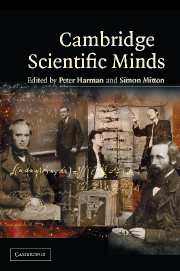Book contents
- Frontmatter
- Contents
- Foreword
- Introduction
- 1 William Gilbert
- 2 William Harvey
- 3 Isaac Newton: Creator of the Cambridge scientific tradition
- 4 William Whewell: A Cambridge historian and philosopher of science
- 5 Adam Sedgwick: A confident mind in turmoil
- 6 Charles Babbage: Science and reform
- 7 Charles Darwin
- 8 Stokes and Kelvin, Cambridge and Glasgow, light and heat
- 9 James Clerk Maxwell
- 10 The duo from Trinity: A.N. Whitehead and Bertrand Russell on the foundations of mathematics, 1895–1925
- 11 Thomson, Rutherford and atomic physics at the Cavendish
- 12 Hopkins and biochemistry
- 13 Charles Sherrington, E.D. Adrian, and Henry Dale: The Cambridge Physiological Laboratory and the physiology of the nervous system
- 14 Hardy and Littlewood
- 15 Arthur Stanley Eddington
- 16 Paul Dirac: A quantum genius
- 17 Alan Turing
- 18 Francis Crick and James Watson
- 19 Mary Cartwright
- 20 Joseph Needham
- 21 Molecular biology in Cambridge
- 22 The discovery of pulsars – prelude and aftermath
- 23 Stephen W. Hawking
21 - Molecular biology in Cambridge
Published online by Cambridge University Press: 05 June 2014
- Frontmatter
- Contents
- Foreword
- Introduction
- 1 William Gilbert
- 2 William Harvey
- 3 Isaac Newton: Creator of the Cambridge scientific tradition
- 4 William Whewell: A Cambridge historian and philosopher of science
- 5 Adam Sedgwick: A confident mind in turmoil
- 6 Charles Babbage: Science and reform
- 7 Charles Darwin
- 8 Stokes and Kelvin, Cambridge and Glasgow, light and heat
- 9 James Clerk Maxwell
- 10 The duo from Trinity: A.N. Whitehead and Bertrand Russell on the foundations of mathematics, 1895–1925
- 11 Thomson, Rutherford and atomic physics at the Cavendish
- 12 Hopkins and biochemistry
- 13 Charles Sherrington, E.D. Adrian, and Henry Dale: The Cambridge Physiological Laboratory and the physiology of the nervous system
- 14 Hardy and Littlewood
- 15 Arthur Stanley Eddington
- 16 Paul Dirac: A quantum genius
- 17 Alan Turing
- 18 Francis Crick and James Watson
- 19 Mary Cartwright
- 20 Joseph Needham
- 21 Molecular biology in Cambridge
- 22 The discovery of pulsars – prelude and aftermath
- 23 Stephen W. Hawking
Summary
In 1936, I left my home town, Vienna, for Cambridge, to seek the Great Sage. He was an Irish Catholic converted to Communism, a mineralogist who had turned to X-ray crystallography: J.D. Bernal. I asked the Great Sage: ‘How can I solve the secret of Life?’ and he replied: ‘The secret of life is in the structure of proteins, and there is only one way of solving it and that is X-ray crystallography.’ So I became an X-ray crystallographer. We called him the Sage because he knew everything from history to physics. His conversation was the most fascinating of anyone I have ever come across. Actually, what had attracted me to Cambridge was not the Sage. It was the lectures of a young organic chemist in Vienna who told me of the work being done in the biochemistry laboratory headed by Gowland Hopkins, one of the founders of biochemistry.
Hopkins had shown that all chemical reactions in living cells are speeded up by enzymes. They are catalysed, chemists say. And he showed that all enzymes are proteins. The remarkable thing in the living cell is that chemical reactions go on at room temperature, in water, at near neutral pH. When chemists make these reactions happen, they need strong solvents or high pressures, or a vacuum, or strong acids and alkalis. In the living cell they take place without any of these, because there is a special protein that speeds up each particular reaction – and speeds it up by a fantastic amount.
- Type
- Chapter
- Information
- Cambridge Scientific Minds , pp. 313 - 324Publisher: Cambridge University PressPrint publication year: 2002



